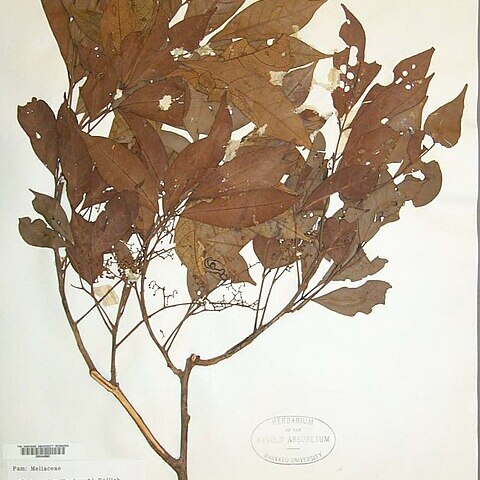Tree up to 20 m, sometimes flowering at 4 m. Bole up to 50 cm diam.; buttresses upwards up to 1.5 m, outwards up to 50 cm and up to 15 cm thick. Outer bark reddish-brown, yellowish-brown or greyish-green, flaking to expose orange-brown bark be-neath; inner bark pink or brown; sapwood pale brown, red or yellow; latex white. Twigs densely covered with reddish-brown, pale brown or orange brown stellate hairs and scales or peltate scales which have an irregular or fimbriate margin. Leaves up to 44 cm long and 40 cm wide; petiole 3.5–9 cm, petiole, rachis and petiolules with few to den-sely covered with hairs or scales like those on the twigs. Leaflets 5–9(–11), (4–)5.5– 23 by (1.8–)2–9 cm, often pale brown or yellowish–brown when dry, often coriace-ous, acuminate at apex, rounded or cuneate at the slightly asymmetrical base, with few to numerous hairs or scales like those on the twigs on the midrib below and occasional on the rest of that surface, often with numerous reddish-brown pits on the upper and lower surfaces; veins 5–16 on each side of the midrib, reticulation subprominent or visible below, petiolules 5–12(–20) mm on lateral leaflets. Inflorescences usually in the axils of the leaves, sometimes borne on the older wood of twigs. Male inflorescence up to 38 cm long and 32 cm wide, peduncle 0.5–5 cm, peduncle, rachis and branches with numerous to densely covered with hairs or scales like those on the twigs. Male flowers 1–1.5 mm long, 1–1.8 mm wide, pedicels 0.5–1.5 mm, densely covered with pale brown or reddish-brown stellate scales or orange brown peltate scales. Calyx with few to densely covered with scales like those on the pedicels. Petals (4 or) 5. Staminal tube cup shaped, 0.5–1 mm long, up to 1.3 mm wide, thickened inside below the insertion of the anthers, aperture 0.6–1 mm, margin lobed; anthers 5 (6), 0.4–0.5 mm long, 0.2–0.5 mm wide, ovoid, inserted half way down the tube, either included and visible or protruding through aperture, sometimes dehiscent in the lower half only. Female in-florescence c. 5 cm long and 4 cm wide; peduncle up to 2.5 cm. Female flowers c. 2 mm long and 2.2 mm wide, pedicels nearly 2 mm. Petals 5(–7). Staminal tube 1 mm long, cup shaped, aperture c. 1 mm, anthers 5, c. 0.5 mm long and 0.4 mm wide, included or protruding from the aperture of the staminal tube; otherwise like the male. Infructes– cence 7–12 cm long and 7–10 cm wide; peduncle up to 2.5 cm, peduncle, rachis and branches with few to numerous hairs or scales like those on the inflorescence. Fruits up to 3 2 cm long and 3.8 cm in diam., subglobose with a central depression at the apex, grey or greenish-brown when unripe, dull orange or brown or yellow when ripe; peri-carp 3–6 mm thick, woody or granular, often with numerous warts, with numerous to densely covered with small pale brown or nearly white peltate scales which have a fim-briate margin, pale brown on the outside and rugulose inside, sometimes with white latex. Locules 3, each containing 0–1 seed. Seed pale brown with a complete, thick, sour, juicy, translucent, white or orange-brown edible aril, up to 2 mm thick; seed without aril 14–20 mm long, 10–19 mm wide and 5–9 mm through, with the main vascular bundle running through the raphe and antiraphe, divaricately branching from the raphe over the sides of the seed; cotyledons subequal, obliquely transverse.
More
Trees 5-9 m tall, to 30 cm d.b.h. Bark rufous. Young branches pale brown, glabrous, with inconspicuous lenticels. Leaves 25-30 cm; petiole and rachis 10-15 cm, glabrous but sparsely brown squamate when young; leaflets 7(-11), alternate to subopposite; petiolules 3-11 mm, slightly inflated; leaflet blades ovate-oblong to elliptic, 5-10(-22) × 1.5-4(-11) cm, papery, both surfaces glabrous but abaxially sparsely lepidote along midvein, midvein abaxially prominent and adaxially conspicuously depressed, secondary veins 9-12 on each side of midvein and abaxially prominent, base rounded to cuneate, apex acute to acuminate. Thyrses axillary, 5-15 cm, sparsely branching, brown squamate. Flowers subsessile, globose, ca. 2 mm in diam. Calyx 5-lobed; lobes rounded, sparsely brown squamate, margin ciliate. Petals 5, broadly ovate, glabrous. Staminal tube globose, free from petals, glabrous, apical margin entire or undulate; anthers 5, ovoid, inserted on or near throat of tube, included or ± exserted. Style very short; stigma conical, truncate, glabrous. Fruit indehiscent, brown, elliptic, ca. 5.5 × 3-3.5 cm, yellowish lenticellate, densely brown squamate, basally contracted into a 1-1.5 cm stipe, apex plump and turbinate; persistent calyx inconspicuous. Seeds 1-3 per fruit, ellipsoid, ca. 4 cm; hilum to 3 cm. Fl. Nov-Jan, fr. Nov-Jan.
A tree. It grows up to 20 m tall. The trunk is straight. It is 50 cm across. It has buttresses. The bark is smooth and coppery. It has cylindrical branches. They are brown and with a somewhat flaky skin near the tips. The leaves are compound. There are 5-9 leaflets. These taper to the tip. The flowers are many and are small and round. The fruit is a round berry and is velvety. They are up to 3.2 cm long by 3.8 cm across. There is a depression at the end. There are 2-3 seeds.


